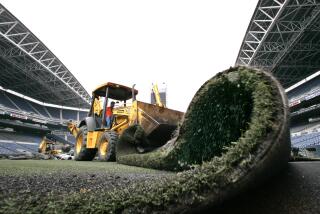Readers React: California drought: lawns are unsustainable, but hold the concrete
- Share via
To the editor: While I am delighted that the homeowner profiled in this article (“Water one-percenters get a nudge,” June 26) has learned that his 7,000-square-foot lawn is not sustainable in this drought, I am saddened that he is planning to replace 5,000 square feet of it with artificial turf and concrete.
I hope this is a temporary measure until he can learn more about drought-tolerant plants.
Concrete adds to the heat, and neither remedy will help much with runoff when there is rain again. The Sherman Oaks area is filled with birds and wildlife; let’s not entirely remove their habitat too.
Rose Leibowitz, Sherman Oaks
..
To the editor: I recommend that the Department of Water and Power spend less time on usage analysis and letter writing and more time on its primary mission: delivery of potable water.
Let’s not forget that less than a year ago, a break in the water delivery system that the DWP is chartered to maintain resulted in a multimillion-gallon spill.
Bruce Major, Newport Beach
..
To the editor: Please tell readers that replacing their yards with concrete is no solution to the drought.
If and when rain comes, all that water will simply run off rather than soak into the ground where it is needed. Better to plant low-water-use succulents in that area.
If the subject of your article would like help, he is welcome to take a look at my yard. I will also show him how easy it is to connect a rain barrel to the washer and use the rinse water for watering.
Jenny Law, Orange
..
To the editor: By replacing lawns and living plants with artificial grass, concrete and gravel, we are doing significantly more damage to our environment.
Fewer living plants and more artificial turf will create more carbon dioxide, more ground heat and less water to recharge the aquifers. Doesn’t anyone see the consequences?
S.R. Fischer, Los Angeles
More to Read
A cure for the common opinion
Get thought-provoking perspectives with our weekly newsletter.
You may occasionally receive promotional content from the Los Angeles Times.










